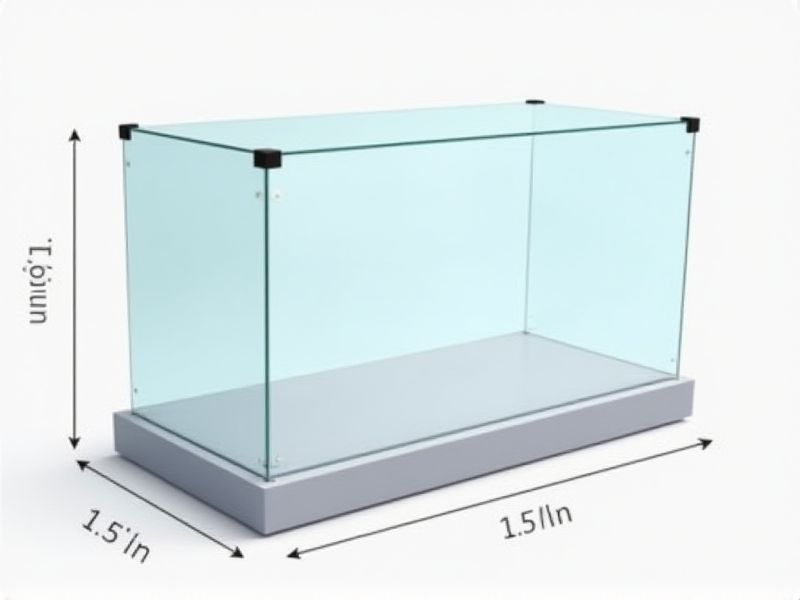
When considering the standard dimensions of a display case, it's helpful to know that most commonly used sizes are designed to accommodate a variety of items and fit well in typical retail or exhibition spaces. For example, a standard countertop display case often measures around 36 inches wide, 18 inches deep, and 12 inches high, making it suitable for jewelry, collectibles, or small merchandise. Larger freestanding display cases typically range from 48 to 72 inches high, 18 to 24 inches deep, and 36 to 72 inches wide. Choosing the right size depends on your available space and the types of items you plan to showcase, so measuring your space and considering your display needs beforehand ensures an optimal fit.
Height
The standard height for a retail display case typically ranges from 36 to 60 inches, depending on the intended use and visibility requirements. A height of 48 inches is commonly selected, as it allows for easy viewing while standing or sitting. Display cases over 60 inches are generally used for specialized products, providing an elevated perspective to attract attention. Choosing the right height not only enhances product visibility but also optimizes customer engagement within your space.
Width
The standard width of a display case typically ranges from 24 inches to 48 inches, catering to various retail and exhibition needs. This measurement allows for optimal visibility and accessibility, ensuring that items are easily viewed and reached by customers. Customizable options may extend up to 72 inches or more for larger displays, accommodating a variety of product sizes. By selecting the appropriate width for your display case, you enhance the presentation of your merchandise while maximizing floor space efficiency.
Depth
The depth of a standard display case typically ranges from 12 to 24 inches, providing adequate space for showcasing various items. A depth of 18 inches is often considered ideal, as it allows for a clear view of merchandise while maximizing storage capacity. When selecting a display case, consider how the depth will accommodate your specific items, whether they are small collectibles or larger products. You may also find that the right depth enhances visibility and organization, effectively drawing attention to your displayed goods.
Shelf Size
The standard shelf size for display cases typically ranges from 24 to 48 inches in width, accommodating various product dimensions. Each shelf can support a weight capacity of approximately 50 to 100 pounds, ideal for showcasing heavy items. The height between shelves usually measures between 10 to 16 inches, allowing for flexible arrangement of merchandise. For optimal visibility, consider transparent materials which enhance your product presentation while maintaining structural integrity.
Glass Thickness
The standard glass thickness for display cases typically ranges from 3mm to 6mm, depending on the size and purpose of the case. In retail settings, thicker glass, such as 6mm, is preferred for its durability and ability to withstand frequent handling. For smaller display cases, a 4mm glass thickness often balances strength and weight, ensuring both security and ease of use. When selecting glass thickness, consider the weight of items being displayed and the overall design to enhance visibility while providing structural integrity.
Door Type
When selecting a display case, the door type significantly influences both accessibility and security. Common options include sliding doors, hinged doors, and bi-fold doors, each providing different user experiences; for instance, sliding doors save space and allow for easy access in tight areas, while hinged doors offer a traditional look and full visibility of items inside. The choice of glass--tempered or acrylic--also affects durability and clarity, ensuring your displayed items are protected from dust and damage. For optimal functionality, consider features like locking mechanisms and adjustable shelving that accommodate various item sizes and enhance your display's overall presentation.
Material
A display case typically features materials that enhance both durability and aesthetics, with glass and wood being the most common choices. Tempered glass, known for its strength and safety, is often used for the front panels, providing clarity and protection for valuable items. High-quality hardwoods, such as oak or maple, may be employed for the frame and shelving, offering a robust structure and a classic appearance. For a modern touch, some cases incorporate metal elements, like stainless steel or aluminum, which add a sleek finish while ensuring longevity.
Base Dimensions
The base dimensions of a standard display case typically measure 36 inches in width, 18 inches in depth, and 30 inches in height. These dimensions provide a stable platform for showcasing products while ensuring visibility from different angles. The design often accommodates various shelf configurations, allowing you to customize the interior space according to your display needs. A solid base ensures durability and supports the overall weight of the display case, which can range from 50 to 200 pounds depending on the materials used.
Lighting Installation
When choosing a display case, consider lighting installation as a crucial element that enhances visibility and aesthetic appeal. LED lights, known for their longevity and energy efficiency, are often preferred, providing bright illumination without generating excessive heat. Proper placement of lights, whether top-mounted or embedded, can highlight products effectively, drawing attention to key features and details. Ensure that your display case incorporates adjustable lighting options to create versatile displays suitable for various products and environments.
Weight Capacity
The weight capacity of a standard display case typically ranges between 50 to 300 pounds, depending on the materials used and its construction quality. For glass display cases, the tempered glass shelves can usually support around 50 to 80 pounds each, offering durability while maintaining a sleek appearance. Wooden display cases generally have a higher weight capacity, often accommodating heavier items due to their sturdy build. Ensure that your display case is appropriately rated for the items you plan to showcase to prevent damage and ensure safety.
